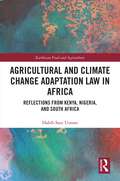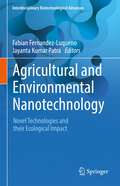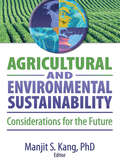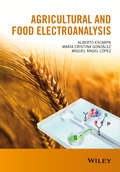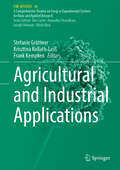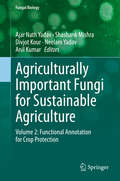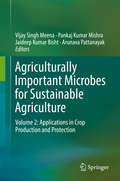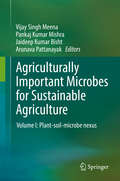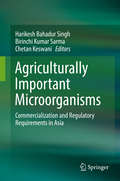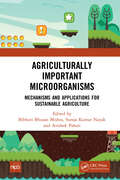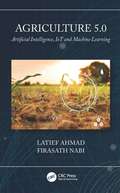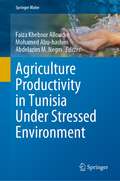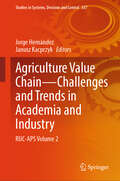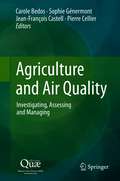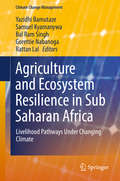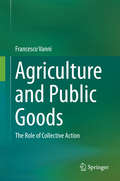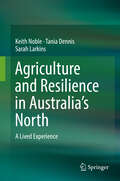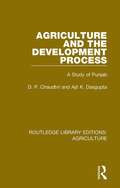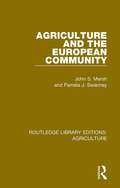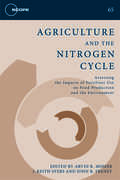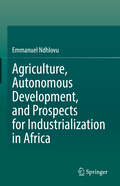- Table View
- List View
Agricultural Waste: Utilization and Industrial Technologies toward Sustainable Management
by S. M. Sapuan R. A. Ilyas M. I. Tahir Muhammad Asyraf Rizal M.S.N. AtikahThis book provides a comprehensive overview of agricultural waste and its utilization in various industrial technologies for sustainable management. It covers a wide range of topics, including the characterization of agricultural waste, its environmental impacts, and its utilization in various industrial sectors. This book also discusses the latest technological advancements in the conversion of agricultural waste into value-added products and the opportunities and challenges associated with their implementation.Key Features: Discusses the environmental impacts of agricultural waste and the latest technological advancements in converting waste into value-added products Gives an overview of the use of agricultural waste in various industrial applications including biocomposite, pulp and paper, and bioenergy industries Considers economic, social, and environmental aspects of agricultural waste management Offers practical solutions for the effective utilization of agricultural waste toward sustainable development Offering a multidisciplinary approach, this book serves as a valuable resource for researchers, academics, policymakers, and engineers interested in the sustainable management of agricultural waste.
Agricultural and Climate Change Adaptation Law in Africa: Reflections from Kenya, Nigeria, and South Africa (Earthscan Food and Agriculture)
by Habib Sani UsmanThis book presents an analysis of climate change and agricultural laws in Kenya, Nigeria, and South Africa in order to determine whether they adequately addressed the concept of agricultural adaptation.Agriculture is one of the sectors of the economy that is contributing to climate change, and at the same time the sector is heavily impacted by climate change. Therefore agricultural adaptation is required. Focusing on three countries, this book provides a novel, comparative examination of how and to what extent the law promotes agriculture-focused adaptation in these countries. The role of the law in addressing issues such as water management strategies, soil conservation methods, and crop production methods is discussed. This book identifies gaps in the regulatory frameworks for agricultural adaptation and highlights the lack of adaptive capacity of African agriculture due to weak or non-existing legal frameworks. It discusses ways to remedy these gaps through specific on-farm adaptation strategies, legislative amendments to consolidate all relevant national climate change-related policies and laws with agricultural policies and laws that have relevant provisions on adaptation as medium-term solutions, and the development of a specific framework law for agriculture-focused adaptation, incorporating essential agricultural adaptation strategies, could perhaps be enacted as long-term solutions to the regulatory gaps.This book will be of great interest to students and scholars of law, climate change, food and agriculture, sustainable development, and African studies.
Agricultural and Environmental Nanotechnology: Novel Technologies and their Ecological Impact (Interdisciplinary Biotechnological Advances)
by Jayanta Kumar Patra Fabian Fernandez-LuquenoThis book highlights the best practices regarding nanoscience and nanotechnology for agriculture and environmental sectors to shape sustainable development thought to improve the quality and quantity of the agriculture products and to decrease the collateral effect of nanotechnology in the ecosystems. Besides, leading nanotechnologies are showed and discussed to guarantee their proper management in lands and ecosystems. Therefore, nanotechnologies such as agronanobiotechnology, nanofertilization, pest control, magnetofection for plant breeding, plant molecular farming, OMICs technologies, phytonanotechnology, nanoremediation, etc. are described in five sections and 21 chapters. Undoubtedly it is an ideal and updated book for undergraduate or postgraduate students, and scientists or researchers involved in nanoscience, nanotechnology, crop production, and remediation technologies as well as for those researchers that solving technical problems regarding the crop management and the human and environmental health without hampering the pursuit of sustainable development goals.
Agricultural and Environmental Sustainability: Considerations for the Future
by Manjit S. KangUnderstand sustainable development from economic, ecological, and social perspectivesAs world population continues to increase, the need grows for a safe, sustainable supply of food. Agricultural and Environmental Sustainability: Considerations for the Future provides the latest research results and vital information on the process of p
Agricultural and Food Electroanalysis
by Alberto Escarpa María Cristina González Miguel Ángel LópezAgricultural and Food Electroanalysis offers a comprehensive rationale of electroanalysis, revealing its enormous potential in agricultural food analysis. A unique approach is used which fills a gap in the literature by bringing in applications to everyday problems. This timely text presents in-depth descriptions about different electrochemical techniques following their basic principles, instrumentation and main applications. Such techniques offer invaluable features such as inherent miniaturization, high sensitivity and selectivity, low cost, independence of sample turbidity, high compatibility with modern technologies such as microchips and biosensors, and the use of exciting nanomaterials such as nanoparticles, nanotubes and nanowires. Due to the advantages that modern electroanalytical techniques bring to food analysis, and the huge importance and emphasis given today to food quality and safety, this comprehensive work will be an essential read for professionals and researchers working in analytical laboratories and development departments, and a valuable guide for students studying for careers in food science, technology and chemistry.
Agricultural and Industrial Applications (The Mycota #16)
by Frank Kempken Stefanie Grüttner Krisztina Kollath-LeißThis volume provides an overview of the current state of the art in agricultural and industrial mycology. It highlights the importance and potential of fungi in these fields. Several topics relate to the critical and ambiguous role of fungi in agriculture, including beneficial and pathogenic fungal-plant interactions and food spoilage caused by mycotoxins. In addition, this volume provides a fascinating insight into ergot alkaloids. The impact of climate change on the occurrence of pathogenic fungi is also discussed. Fungi play an important role in a wide range of industrial processes, including the fermentation of food and beverages and the biotechnological production of metabolites and enzymes. A number of specific applications are discussed in this volume, such as the production of vitamins and enzymes from marine fungi. In addition to mycologists working in industry, agriculture and academia, the book will be of interest to students of biotechnology, microbiology and mycology. Chapter 3 is available open access under a Creative Commons Attribution 4.0 International License via link.springer.com.
Agriculturally Important Fungi for Sustainable Agriculture: Volume 1: Perspective for Diversity and Crop Productivity (Fungal Biology)
by Anil Kumar Ajar Nath Yadav Shashank Mishra Neelam Yadav Divjot KourMicrobes are ubiquitous in nature. Among microbes, fungal communities play an important role in agriculture, the environment, and medicine. Vast fungal diversity has been associated with plant systems, namely epiphytic fungi, endophytic fungi, and rhizospheric fungi. These fungi associated with plant systems play an important role in plant growth, crop yield, and soil health. Rhizospheric fungi, present in rhizospheric zones, get their nutrients from root exudates released by plant root systems, which help with their growth, development, and microbe activity. Endophytic fungi typically enter plant hosts through naturally occurring wounds that are the result of plant growth, through root hairs, or at epidermal conjunctions. Phyllospheric fungi may survive or proliferate on leaves depending on material influences in leaf diffuseness or exudates.The diverse nature of these fungal communities is a key component of soil-plant systems, where they are engaged in a network of interactions endophytically, phyllospherically, as well as in the rhizosphere, and thus have emerged as a promising tool for sustainable agriculture. These fungal communities promote plant growth directly and indirectly by using plant growth promoting (PGP) attributes. These PGP fungi can be used as biofertilizers and biocontrol agents in place of chemical fertilizers and pesticides for a more eco-friendly method of promoting sustainable agriculture and environments.This first volume of a two-volume set covers the biodiversity of plant-associated fungal communities and their role in plant growth promotion, the mitigation of abiotic stress, and soil fertility for sustainable agriculture. This book should be useful to those working in the biological sciences, especially for microbiologists, microbial biotechnologists, biochemists, and researchers and scientists of fungal biotechnology.
Agriculturally Important Fungi for Sustainable Agriculture: Volume 2: Functional Annotation for Crop Protection (Fungal Biology)
by Anil Kumar Ajar Nath Yadav Shashank Mishra Neelam Yadav Divjot KourMicrobes are ubiquitous in nature. Among microbes, fungal communities play an important role in agriculture, the environment, and medicine. Vast fungal diversity has been found in plant systems. The fungi associated with any plant system are in the form of epiphytic, endophytic, and rhizospheric fungi. These associated fungi play important roles in plant growth, crop yield, and soil health.The rhizospheric fungi present in rhizospheric zones have a sufficient amount of nutrients released by plant root systems in the form of root exudates for growth, development, and activities of microbes. Endophytic fungi enter in host plants mainly through wounds that naturally occur as a result of plant growth, or develop through root hairs and at epidermal conjunctions. The phyllospheric fungi may survive or proliferate on leaves, depending on the extent of influences of material in leaf diffuseness or exudates. The diverse group of fungal communities is a key component of soil-plant systems, where they are engaged in an intense network of interactions in the rhizospheric, endophytic, and phyllospheric areas, and they have emerged as an important and promising tool for sustainable agriculture. These fungal communities help to promote plant growth directly or indirectly by mechanisms for plant growth-promoting (PGP) attributes. These PGP fungi can be used as biofertilizers, bioinoculants, and biocontrol agents in place of chemical fertilizers and pesticides in an environmentally and eco-friendly manner. This book covers the current knowledge of plant-associated fungi and their potential biotechnological applications in agriculture and allied sectors. This book should be useful to scientists, researchers, and students of microbiology, biotechnology, agriculture, molecular biology, environmental biology, and related subjects.
Agriculturally Important Microbes for Sustainable Agriculture: Volume 2: Applications in Crop Production and Protection
by Jaideep Kumar Bisht Vijay Singh Meena Pankaj Kumar Mishra Arunava PattanayakThis book presents a compilation of case studies from different countries on achieving agricultural sustainability. The book stresses that, in order to meet the needs of our rapidly growing population, it is imperative to increase agricultural productivity. If global food production is to keep pace with an increasing population, while formulating new food production strategies for developing countries, the great challenge for modern societies is to boost agricultural productivity. Today, the application of chemicals to enhance plant growth or induced resistance in plants is limited due to the negative effects of chemical treatment and the difficulty of determining the optimal concentrations to benefit the plant. In the search for alternative means to solve these problems, biological applications have been extensively studied. Naturally occurring plant-microbe-environment interactions are utilized in many ways to enhance plant productivity. As such, a greater understanding of how plants and microbes coexist and benefit one another can yield new strategies to improve plant productivity in the most sustainable way. Developing sustainable agricultural practices requires understanding both the basic and applied aspects of agriculturally important microorganisms, with a focus on transforming agricultural systems from being nutrient-deficient to nutrient-rich. This work is divided into two volumes, the aim being to provide a comprehensive description and to highlight a holistic approach, respectively. Taken together, the two volumes address the fundamentals, applications, research trends and new prospects of agricultural sustainability. Volume one consists of two sections, with the first addressing the role of microbes in sustainability, and the second exploring beneficial soil microbe interaction in several economically important crops. Section I elucidates various mechanisms and beneficial natural processes that enhance soil fertility and create rhizospheric conditions favourable for high fertility and sustainable soil flora. It examines the mechanism of action and importance of rhizobacteria and mycorrhizal associations in soil. In turn, section II presents selected case studies involving economically important crops. This section explains how agriculturally beneficial microbes have been utilized in sustainable cultivation with high productivity. Sustainable food production without degrading the soil and environmental quality is a major priority throughout the world, making this book a timely addition. It offers a comprehensive collection of information that will benefit students and researchers working in the field of rhizospheric mechanisms, agricultural microbiology, biotechnology, agronomy and sustainable agriculture, as well as policymakers in the area of food security and sustainable agriculture.
Agriculturally Important Microbes for Sustainable Agriculture: Volume I: Plant-soil-microbe nexus
by Jaideep Kumar Bisht Vijay Singh Meena Pankaj Kumar Mishra Arunava PattanayakThis book presents a compilation of case studies from different countries on achieving agricultural sustainability. The book stresses that, in order to meet the needs of our rapidly growing population, it is imperative to increase agricultural productivity. If global food production is to keep pace with an increasing population, while formulating new food production strategies for developing countries, the great challenge for modern societies is to boost agricultural productivity. Today, the application of chemicals to enhance plant growth or induced resistance in plants is limited due to the negative effects of chemical treatment and the difficulty of determining the optimal concentrations to benefit the plant. In the search for alternative means to solve these problems, biological applications have been extensively studied. Naturally occurring plant-microbe-environment interactions are utilized in many ways to enhance plant productivity. As such, a greater understanding of how plants and microbes coexist and benefit one another can yield new strategies to improve plant productivity in the most sustainable way. Developing sustainable agricultural practices requires understanding both the basic and applied aspects of agriculturally important microorganisms, with a focus on transforming agricultural systems from being nutrient-deficient to nutrient-rich. This work is divided into two volumes, the aim being to provide a comprehensive description and to highlight a holistic approach, respectively. Taken together, the two volumes address the fundamentals, applications, research trends and new prospects of agricultural sustainability. Volume one consists of two sections, with the first addressing the role of microbes in sustainability, and the second exploring beneficial soil microbe interaction in several economically important crops. Section I elucidates various mechanisms and beneficial natural processes that enhance soil fertility and create rhizospheric conditions favourable for high fertility and sustainable soil flora. It examines the mechanism of action and importance of rhizobacteria and mycorrhizal associations in soil. In turn, section II presents selected case studies involving economically important crops. This section explains how agriculturally beneficial microbes have been utilized in sustainable cultivation with high productivity. Sustainable food production without degrading the soil and environmental quality is a major priority throughout the world, making this book a timely addition. It offers a comprehensive collection of information that will benefit students and researchers working in the field of rhizospheric mechanisms, agricultural microbiology, biotechnology, agronomy and sustainable agriculture, as well as policymakers in the area of food security and sustainable agriculture.
Agriculturally Important Microorganisms: Commercialization and Regulatory Requirements in Asia
by Harikesh Bahadur Singh Chetan Keswani Birinchi Kumar SarmaThe main focus of this book is to survey the current status of research, development and use of agriculturally important microorganisms in Asian countries and develop a strategy for addressing critical issues various policy constraints due to which bio-pesticides have found limited applications. In this book the editors have tried to develop a consensus on issues of such as quality requirements, quality control, regulatory management, commercialization and marketing of agriculturally important microorganisms in Asian countries. All these issues are discussed at national level by competent authorities of Asian countries including India, China, Malaysia, Iran, Taiwan, Israel, Sri Lanka, Vietnam and Philippines.
Agriculturally Important Microorganisms: Mechanisms and Applications for Sustainable Agriculture
by Bibhuti Bhusan Mishra Suraja Kumar Nayak Avishek PahariThe book encompasses different Agriculturally Important microorganisms (AIMs), mechanisms of action and modes of application for sustainable agriculture. The potential of microbes in nitrogen fixation, solubilizing nutrients like phosphorous, Potassium, tolerance to etc. are the major strength of the book. There is relatively a new frontier, use of Plant Growth Promoting Rhizobacteria(PGPR)in enhancing crop productivity. These microbes inhabit at the rhizospheric region of the root and facilitate plant growth through a variety of direct and indirect mechanisms. These PGP have been identified to solubilize phosphate, Potassium, Zinc, produce siderophore, IAA, Hydrogencyanide, fix ammonia and many more. Today, such microbes are extensively studied not only as a biofertilizer or fortification of nutrient to the plant, but also a potential agent to decrease application of chemical fertilizer and other agrochemicals. The book also gives an insight to this aspect also. Last but not the least,a light has been thrown on use and application of nano-biofertilizer for sustainable agriculture.Note: T&F does not sell or distribute the hardback in India, Pakistan, Nepal, Bhutan, Bangladesh and Sri Lanka. This title is co-published with NIPA.
Agriculture 5.0: Artificial Intelligence, IoT and Machine Learning
by Latief Ahmad Firasath NabiAgriculture 5.0: Artificial Intelligence, IoT & Machine Learning provides an interdisciplinary, integrative overview of latest development in the domain of smart farming. It shows how the traditional farming practices are being enhanced and modified by automation and introduction of modern scalable technological solutions that cut down on risks, enhance sustainability, and deliver predictive decisions to the grower, in order to make agriculture more productive. An elaborative approach has been used to highlight the applicability and adoption of key technologies and techniques such WSN, IoT, AI and ML in agronomic activities ranging from collection of information, analysing and drawing meaningful insights from the information which is more accurate, timely and reliable.It synthesizes interdisciplinary theory, concepts, definitions, models and findings involved in complex global sustainability problem-solving, making it an essential guide and reference. It includes real-world examples and applications making the book accessible to a broader interdisciplinary readership. This book clarifies hoe the birth of smart and intelligent agriculture is being nurtured and driven by the deployment of tiny sensors or AI/ML enabled UAV’s or low powered Internet of Things setups for the sensing, monitoring, collection, processing and storing of the information over the cloud platforms. This book is ideal for researchers, academics, post-graduate students and practitioners of agricultural universities, who want to embrace new agricultural technologies for Determination of site-specific crop requirements, future farming strategies related to controlling of chemical sprays, yield, price assessments with the help of AI/ML driven intelligent decision support systems and use of agri-robots for sowing and harvesting. The book will be covering and exploring the applications and some case studies of each technology, that have heavily made impact as grand successes. The main aim of the book is to give the readers immense insights into the impact and scope of WSN, IoT, AI and ML in the growth of intelligent digital farming and Agriculture revolution 5.0.The book also focuses on feasibility of precision farming and the problems faced during adoption of precision farming techniques, its potential in India and various policy measures taken all over the world. The reader can find a description of different decision support tools like crop simulation models, their types, and application in PA. Features: Detailed description of the latest tools and technologies available for the Agriculture 5.0. Elaborative information for different type of hardware, platforms and machine learning techniques for use in smart farming. Elucidates various types of predictive modeling techniques available for intelligent and accurate agricultural decision making from real time collected information for site specific precision farming. Information about different type of regulations and policies made by all over the world for the motivation farmers and innovators to invest and adopt the AI and ML enabled tools and farming systems for sustainable production.
Agriculture Productivity in Tunisia Under Stressed Environment (Springer Water)
by Abdelazim M. Negm Mohamed Abu-Hashim Faiza Khebour AlloucheThis book highlights recent efforts to sustain agricultural productivity in Tunisia under a stressed environment and aridity conditions. This book's authors gathered a unique set of applications and approaches, including techniques applied to increase yield and preserve the environment, such as organic farming and using biochar amendment and its effects on soils' physicochemical properties. This book also presents water resources management and water management practices for sustainable soil production, diagnosis, and new farming technologies to enhance water-use efficiency. The book also addresses current livestock strategies intended to maintain production sustainability, increase fish productivity, and initiatives for sustainable tourism development.Given its scope, the book offers a valuable guide for policy planners, decision-makers, stakeholders, researchers, and graduate students in Tunisia and neighboring countries with similarly stressed environmental conditions.
Agriculture Sector Transformation in Nepal: A Roadmap
by Dinesh Panday Jagadish Timsina Prabhat Khanal Bishnu Raj UpretiThis book addresses the significant challenges faced by Nepal's agriculture sector, including political changes, regional geopolitical interests, technical inadequacies, and poor governance. Comprehensive sectoral restructuring, political commitment, new institutional and legal frameworks, and governance reforms are essential, while carefully navigating regional geopolitical complexities. The book provides a roadmap for restructuring Nepal's agriculture sector, with scientifically robust chapters, that address policy and climate change issues, and align with national policies. It serves as a blueprint for tackling food insecurity in developing countries, particularly in South Asia, facing similar research, policy, and geopolitical challenges.
Agriculture Value Chain — Challenges and Trends in Academia and Industry: RUC-APS Volume 2 (Studies in Systems, Decision and Control #557)
by Janusz Kacprzyk Jorge HernándezThis book stands as a significant milestone in the realm of agricultural research and innovation, representing the comprehensive efforts of the RUC-APS Project. The RUC-APS Project, officially known as "Enhancing and Implementing Knowledge-Based ICT Solutions Within High-Risk and Uncertain Conditions for Agriculture Production Systems," was a collaborative initiative under the H2020 European Framework, running from October 3, 2016, to April 2, 2022. Spearheaded by the esteemed Prof. Jorge Hernández, formerly of the University of Liverpool, UK, and currently affiliated with Universidad Adolfo Ibañez, Santiago de Chile, the project brought together a consortium of 16 participants from 5 EU countries and 3 partners from 2 third countries. This book marks the culmination of rigorous research and insights garnered through a meticulous peer-review process involving contributions from various RUC-APS international conferences held between 2021 and 2023. It delves into the pressing need to address the challenges faced by modern agricultural systems, particularly agricultural value chains, amidst volatile and uncertain environmental conditions. The ever-changing landscape of resources, coupled with factors like unpredictable weather patterns, pest infestations, market fluctuations, and fluctuating commodity prices, necessitates a holistic and adaptive approach to ensure resilience and sustainability across the agricultural value chain. Navigating these complexities requires informed decision-making processes that account for risks throughout the entire agricultural lifecycle. The complexity of these decision-making paradigms underscores the critical importance of this book and the insights gleaned from the RUC-APS Project. By shedding light on multifaceted challenges and proposing innovative solutions, this collaborative effort aims to pave the way for a more resilient and sustainable agricultural landscape.
Agriculture and Air Quality: Investigating, Assessing and Managing
by Carole Bedos Sophie Génermont Jean-François Castell Pierre CellierThis book gives an overview of the relationships between agriculture and air quality, which is an issue of increasing importance for practitioners and policy makers. It provides the keys to understand natural and anthropogenic mechanisms governing emission and deposition of pollutants produced by and/or impacting agricultural activitiesIt identifies how management practices can help mitigating emissions and how public policies on air pollution progressively addressed the agricultural sectorThis book was written for students, researchers and agriculture actors as well as for public decision-makers
Agriculture and Ecosystem Resilience in Sub Saharan Africa: Livelihood Pathways Under Changing Climate (Climate Change Management)
by Rattan Lal Bal Ram Singh Yazidhi Bamutaze Samuel Kyamanywa Gorettie NabanogaThis volume discusses emerging contexts of agricultural and ecosystem resilience in Sub Saharan Africa, as well as contemporary technological advances that have influenced African livelihoods. In six sections, the book addresses the sustainable development goals to mitigate the negative impacts on agricultural productivity brought about by climate change in Africa. Some of the challenges assessed include soil degradation, land use changes, natural resource mismanagement, declining crop productivity, and economic stagnation. This book will be of interest to researchers, NGOs, and development organizations.Section 1 focuses on climate risk management in tropical Africa. Section 2 addresses the water-ecosystem-agriculture nexus, and identifies the best strategies for sustainable water use. Section 3 introduces Information Communication Technology (ICT), and how it can be used for ecosystem and human resilience to improve quality of life in communities. Section 4 discusses the science and policies of transformative agriculture, including challenges facing crop production and management. Section 5 addresses landscape processes, human security, and governance of agro-ecosystems. Section 6 concludes the book with chapters uniquely covering the gender dynamics of agricultural, ecosystem, and livelihood resilience.
Agriculture and Public Goods: The Role of Collective Action
by Francesco VanniThe debate on the future orientation of the EU Common Agricultural Policy (CAP) is increasingly shaped by the role of agriculture in providing public goods, and there is a broad consensus that this approach will be particularly relevant in legitimating the policy intervention in agriculture in the future. In the context of this debate, it is not clear to what extent collective action could be taken into consideration as a valuable alternative to market or state regulation in contributing to the provision of public goods, and to what extent it is possible to design and implement agricultural policies that incorporate a collective and collaborative approach between different stakeholders in rural areas. Through an in depth analysis two case studies in Italy, the book provides insights to both the policy and the theoretical debate on the role of collective action for the public goods associated to agriculture.
Agriculture and Resilience in Australia’s North: A Lived Experience
by Keith Noble Tania Dennis Sarah LarkinsThis book examines the mechanisms and strategies farmers in North Australia adopt to manage the setbacks and challenges they face. This social research is based on farmers’ experiences, but also draws on the author’s own experience after his tropical fruit farm was destroyed by two Category 5 cyclones in five years.Through historical analysis, the book compares historic and contemporary aspirations for northern development, and discusses the influence of the built environment on individuals as well as access to health and other social services.Exploring the implications of individual resilience strategies for policy development within the broader context of northern development and evolving environmental governance, the book also highlights the fact that this is occurring in a new geological epoch – the Anthropocene.The book will provide a unique perspective and understanding to government, individuals and industries interested in northern Australia and its relationship to the world
Agriculture and Water Management Under Climate Change (SpringerBriefs in Earth System Sciences)
by Öner ÇetinThis book analyzes how major events such as the recent pandemic crisis, wars around the world and climate change, have affected agricultural production and the direct food supply. In this sense, human nutrition will never be off the agenda. The book provides information and guidelines for both practitioners and decision-makers about important developments in the use of agriculture, soil and water resources for agricultural purposes, including the effective and efficient use of soil and water resources where agricultural production, increasing water productivity, the use of modern technology and digitalization for this purpose. Accordingly, a number of chapters have been prepared by experts in the field, covering a variety of the above-mentioned objectives.
Agriculture and the Development Process: A Study of Punjab (Routledge Library Editions: Agriculture #2)
by Ajit K. Dasgupta D. P. ChaudhriFirst published in 1985. The need to increase agricultural output and to use increased output to generate sustained general economic development is a problem facing many Third World countries. This book explores in particular the agricultural growth of the Punjab in Northern India, a country which has long been a leader in the formulation of new development strategies. It shows how agricultural output is affected by, and affects, demographic changes, income distribution, state involvement and structural changes both in society and the economy. Agricultural growth in the Punjab is seen in an historical perspective. In addition, the different aspects of economic development are viewed in an integrated way so that much is learned about the contribution of agricultural growth to the development process. The conclusions drawn can be related to problems and trends worldwide.
Agriculture and the European Community (Routledge Library Editions: Agriculture #3)
by John S. Marsh Pamela J. SwanneyFirst published in 1980. From the earliest beginnings of the European Economic Community, it was recognised that a common market for agriculture would be one of the basic prerequisites for workable economic unity. And yet the Common Agricultural Policy (CAP) remained a subject of much controversy and debate. The CAP, more than any other element of European policy, was seen to test the true depth of the commitment shown by Community members to the practice as well as the principle of economic integration. Agriculture and the European Community examines the reasons for the existence of the CAP and its format. It outlines the main instruments, price and structural policy, and the changing emphasis between them. It discusses in turn the effects of the CAP on producers’ income levels and on consumer prices; how far it had fulfilled the promises of the Treaty of Rome; the implications of the policy for third country trade; and its place within the Community as a whole. The study argues that, although incomes of Community farmers had improved, this is not simply the result of the CAP, nor was the geographical distribution of benefit in terms of farming income satisfactory. The policy has achieved a degree of success in securing food supplies and stabilising prices but the cost to the consumer has been high. Knowledge of the CAP had become almost essential to any understanding of modern European affairs. Agriculture and the European Community will serve as a straightforward introduction to the policy for students approaching the subject for the first time, especially in departments of Agricultural Economics, European Studies and Political Science.
Agriculture and the Nitrogen Cycle: Assessing the Impacts of Fertilizer Use on Food Production and the Environment (SCOPE Series #65)
by John R. Freney Arvin Mosier J. Keith SyersNitrogen is an essential element for plant growth and development and a key agricultural input-but in excess it can lead to a host of problems for human and ecological health. Across the globe, distribution of fertilizer nitrogen is very uneven, with some areas subject to nitrogen pollution and others suffering from reduced soil fertility, diminished crop production, and other consequences of inadequate supply. Agriculture and the Nitrogen Cycle provides a global assessment of the role of nitrogen fertilizer in the nitrogen cycle. The focus of the book is regional, emphasizing the need to maintain food and fiber production while minimizing environmental impacts where fertilizer is abundant, and the need to enhance fertilizer utilization in systems where nitrogen is limited. The book is derived from a workshop held by the Scientific Committee on Problems of the Environment (SCOPE) in Kampala, Uganda, that brought together the world's leading scientists to examine and discuss the nitrogen cycle and related problems. It contains an overview chapter that summarizes the group's findings, four chapters on cross-cutting issues, and thirteen background chapters. The book offers a unique synthesis and provides an up-to-date, broad perspective on the issues of nitrogen fertilizer in food production and the interaction of nitrogen and the environment.
Agriculture, Autonomous Development, and Prospects for Industrialization in Africa
by Emmanuel NdhlovuThe book investigates the intersection of agriculture and development in Africa and how it impacts rural industrialisation prospects. It provides a comprehensive view of the position of agriculture in African socio-economic activities and the agricultural sector's potential as the source for continental development and industrialisation prospects. Significant research has been done on African development with a focus placed on the problematic role played by slavery, colonialism and later by incompetent African leaders who failed to steer development of the type that delivers a progressive, sustained and sustainable transformation of lives and societies. There is limited focus on the possibility of agriculture being the potential basis of African development and the chance for industrialisation. This is a matter of concern, considering the dominance of agriculture as a livelihood and income source for many people on the continent. In contributing to the debate on development in Africa, this book aims to show how agriculture can serve as the basis for African development and industrialisation. This will be achieved by (i) providing a detailed historical description of the position of agriculture in African socio-economic activities, (ii) outlining the trajectory of African development with a focus on agriculture, innovation, and mechanisation, (iii) identifying challenges to the development of African agriculture, (iv) exploring the opportunities for agricultural development in Africa, and (v) providing practical and policy recommendations to improve African agriculture and make it the engine for development and industrialisation. Utilising a multidisciplinary approach which combines political economy, social policy, financial inclusion, and empowerment approaches, the book also shows how engagement of youth and women, digitalisation, and the provision of support (by public and private actors) can jump-start agriculture as the engine of African development and industrialisation. Taken together with this conscious effort to promote a multi-disciplinary discussion, the book is valuable reading for students, policymakers, and activists interested in emerging new directions in African development thinking and research.

